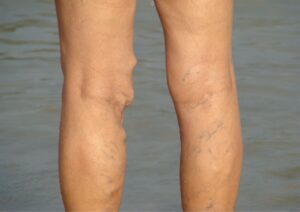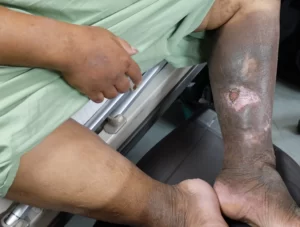Sclerotherapy treatment is a common medical procedure used to treat varicose veins and spider veins. It involves injecting a solution directly into the affected blood vessels, causing them to collapse and eventually be reabsorbed by the body. Sclerotherapy for varicose veins, including foam sclerotherapy, requires precise preparation and administration to ensure effectiveness and safety. While sclerotherapy is generally safe and effective, it’s important to be aware of the potential complications and normal healing side effects that can occur. This blog will delve into both aspects to help you understand what to expect if you’re considering this treatment.
Normal Healing Side Effects of Sclerotherapy Treatment
1. Bruising:
Bruising around the injection site is quite common and typically fades within a few weeks. It’s a normal response to the needle puncture and the injection of the sclerosing solution.
2. Redness and Swelling:
Mild redness and swelling can occur at the injection site. This is usually temporary and should subside within a few days to a week.
3. Itching:
Some patients experience itching in the treated areas. This is a normal part of the healing process and typically resolves on its own.
4. Raised Red Areas:
It’s not unusual to see raised red areas or small red spots at the site of injection. These generally disappear within a few days to a week.
5. Small Skin Sores:
Occasionally, small sores may develop at the injection sites. These are usually minor and heal without any specific treatment.
6. Darkened Skin:
Hyperpigmentation, or darkening of the skin over the treated vein, can occur. This is usually temporary and fades over several months, although in some cases, it may take up to a year to fully resolve.
7. Temporary Vein Lumps:
The treated vein may feel like a lump or cord for several months as it heals. This is a normal part of the body’s process in reabsorbing the treated vein.
Potential Complications of Deep Vein Thrombosis
While sclerotherapy is generally safe, there are potential complications that can arise, though they are rare. It’s important to discuss these with your healthcare provider before undergoing the procedure.
Allergic Reactions:
Some patients may have an allergic reaction to the sclerosing solution. Symptoms can range from mild itching and hives to more severe reactions like difficulty breathing, which require immediate medical attention.
Blood Clots:
There is a small risk of blood clots forming in the treated veins. If a clot travels to a deeper vein, it can lead to deep vein thrombosis (DVT), a more serious condition that requires prompt medical intervention. Larger varicose veins and larger veins pose specific risks, including cramping during the procedure. Compression stockings are often recommended as part of aftercare to prevent further complications. In rare cases, a blood clot can travel to the lungs, causing a pulmonary embolism, which is a serious condition. Monitoring treated vessels is crucial to prevent complications.
Chronic Venous Insufficiency:
Sclerotherapy is a first-line treatment for chronic venous insufficiency, a condition that significantly impacts patients’ quality of life and poses an economic burden on healthcare systems.
Skin Ulcers:
Though rare, skin ulcers can develop at the injection site. These can be painful and require medical treatment to heal properly.
Nerve Damage:
If the sclerosing solution is inadvertently injected near a nerve, it can cause temporary or, in rare cases, permanent nerve damage, leading to pain or numbness.
Foam Sclerotherapy:
Foam sclerotherapy is widely accepted for treating varicose veins but comes with risks such as transient ischemic attacks (TIA) and other neurological complications. Patients undergoing foam sclerotherapy should be aware of these risks and the importance of informed consent and appropriate patient selection.
- Infection:
Any time a needle is used to puncture the skin, there is a risk of infection. This risk is minimized with proper sterilization techniques, but it’s important to monitor the injection sites for signs of infection, such as increased redness, swelling, or pus.
Conclusion on Treated Vein
Sclerotherapy is an effective and relatively low-risk treatment for varicose and spider veins, but like any medical procedure, it comes with its own set of potential complications and normal healing side effects. Understanding these can help you make an informed decision and manage your expectations during the recovery process. Always discuss any concerns with your healthcare provider to ensure you receive the best possible care and guidance tailored to your individual needs.










